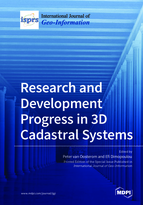Research and Development Progress in 3D Cadastral Systems
A special issue of ISPRS International Journal of Geo-Information (ISSN 2220-9964).
Deadline for manuscript submissions: closed (31 August 2017) | Viewed by 84396
Special Issue Editors
Interests: spatial databases; map generalization; 3D cadastre; point clouds; geomatics
Special Issues, Collections and Topics in MDPI journals
Interests: cadastre; spatial information management; land policy; GIS; 3D cadastres and cadastral modelling
Special Issue Information
Dear Colleagues,
This Special Issue is devoted to all aspects of 3D Cadastres: legal, organization, and technical aspects. This is a subject where practice and research do meet, influence, stimulate and support each other. The Special Issue aims for papers showing the progress in key areas of 3D Cadastres: Legal framework 3D Cadastres, Initial registration of 3D parcels, 3D data management, Visualization, distribution and delivery of 3D parcels.
The increasing complexity of infrastructures and densely built-up areas requires a proper registration of the legal status (private and public), which can only be provided to a limited extent by the existing 2D cadastral registrations. The registration of the legal status in complex 3D situations will be investigated under the header of 3D Cadastres. Typical papers are expected to addresses the following 3D Cadastral topics:
- 3D Cadastre operational experiences (analysis, LADM based, learn from each other, discover gaps)
- 3D Cadastre cost effective work flow for new/updated 3D parcels = 4D (part of whole chain: from planning/design/permit in 3D, to registration/use in 3D)
- 3D Cadastre web-based dissemination (usability, man-machine interfaces, including mobile/AR)
- Legal aspects for 3D Cadastre, best legal practises in various legislation systems
- Focus on large cities, including developing countries
Prof. Dr.ir. Peter van Oosterom
Prof. Dr. Efi Dimopoulou
Guest Editors
Keywords
- 3D cadastres
- spatial databases
- geographic information systems,
- survey plans
- 3D visualization
- rights, restrictions, responsibilities
- standardization
- spatial data infrastructure
- real property
- utility networks






